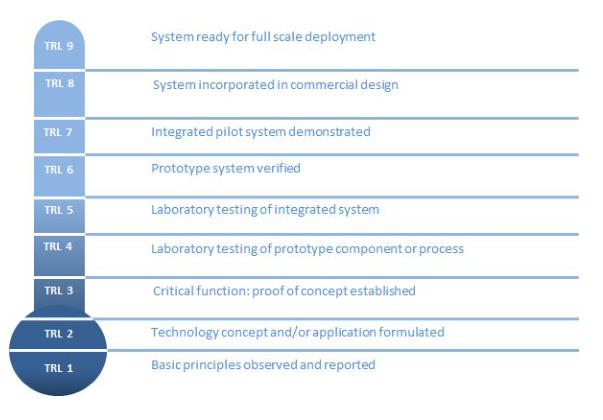Innovative tech firms that pursue Federally funded business opportunities need to be aware and familiar with a term used in the Innovation, Research and Development (IRAD) arena known as Technology Readiness Level (TRL). IRAD projects are investments that the Government makes to get the latest and greatest technological advancements toward their mission space. I’ve shared this topic before as one of the three key ways to pursue Federal business, along with direct contract priming and strategic teaming. These opportunities can be particularly appealing to tech companies that boast commercial innovation and don’t typically do business with our Federal Government, if at all. These innovation, research and development projects can provide an “in” to this lucrative space with lower barriers to entry than those presented to service providers, if and only if the company innovation teeters on the cutting edge.
Technology Readiness Level Definition
So, what is Technology Readiness Level and why do you need to know about it?
According to Wikipedia, “TRLs are a method of estimating technology maturity of Critical Technology Elements (CTE) of a program during the acquisition process.” That’s as good a definition as any, and in simplified terms provides a scale or rating of how ready your innovation is for prime time; that is, operational use in a bona fide Government program. NASA coined the term in the seventies and defined things a bit more tightly in 1989, but TRLs have made their way into the lexicon of other Federal agencies that fund innovation, namely the Department of Defense (DoD), as well as the commercial sector. Given the dwindling state of Federally funded IRAD in the past 50 years (nearly 12% of Federal budget in 1966 vs. 3% in 2016), the DoD still controls a majority of that spend.
Technology Readiness Level Scale
Both NASA and DoD have slightly different definitions for the nine (9) TRLs that show innovation ranging from a back-of-napkin idea (Level 1) to one that is fully deployed in a Federal mission space (Level 9). You can Google and find NASA’s version, the DoD’s, and others. Figure 1 shows a TRL scale that is generic enough for the Government and private sector.


When commercial companies and even seasoned Federal contractors seek to enter this IRAD space, it’s important to know these levels and where your capability or product fits in, because the buyers from this world not only use the Technology Readiness Level terminology but each agency tends to operate at a different level on the curve, with some overlap.
For instance, in my work pursuing and landing these type opportunities for FedTrax clients, I have found that the DoD Research Labs (Army, Navy, Air Force) tend to operate on the lower levels of the scale (1-3). Level 1 could be considered Basic Research, Level 2 termed Applied Research, and Level 3 is where we start getting into early stage prototyping, actually trying to build something. Other funding sources live at higher levels of the scale, such as the DoD Strategic Capabilities Office (SCO) and the Army Rapid Capabilities Office (RCO). Those agencies are looking for innovation that is TRL 6 or 7, things that are only 6-18 months away from actual field deployment at TRL 9.
Regarding TRL 9, if your company has a commercial device or software that is actively being sold, you might think you are in TRL 9 land for the Federal Government, but you’d be wrong, You are really at TRL 7 or 8, because in the eyes of the Government buyer, you are not at TRL 9 until your thing is gold plated for use in a production, Government program. In software, this means things like fully cyber compliant to the Risk Management Framework (RMF) construct so that the tool can obtain a Federal Authority to Operate (ATO) on a Government system without delay. At that point, you can claim TRL 9 status.
Technology Readiness Level and Business Development
There are many resources available to learn more about TRL. For companies that are looking to get the next multi-million-dollar DARPA contract (very hard to do but not impossible) or even introduce a new technology as a loss leader to gain exposure into a strategic target agency, a working knowledge is necessary. There is overlap between these stages depending upon the interpreter, but you need at least a range (between TRL 4-6) to learn which Federal agencies to pursue with your capability. You can usually find this information on an agency website, so do your homework. If what your company offers is not yet at the level that a funding agency requires, either find another outlet or further develop what you have until it’s in the range. By knowing the terminology and where you stand, you increase your likelihood of finding Government monies to fund further development, AND to get you on the map in the wonderful world of Federal Innovation, Research and Development.




